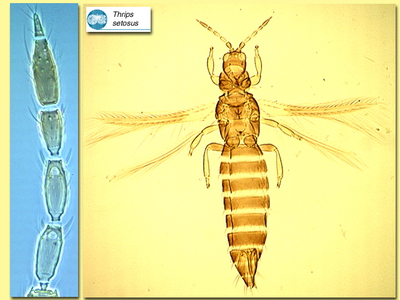Figures
Fig. 1 Antenna and head (dorsal)
Fig. 2 Head (dorsal)
Fig. 3 Pronotum
Fig. 4 Meso- and metanotum
Fig. 5 Fore and hind wing
Fig. 6 Pleurotergites and sternites IV
Fig. 7 Tergite VIII (female)
Species
Thrips setosus Moulton
Biology
This species is common in Japan, living in the flowers and on the leaves of a very wide range of plants.
Distribution
Widespread in Japan and recorded from Korea.
Recognition
Body brown, tarsi yellow, tibiae variably brownish yellow; antennal segments I-II brown, III yellow with brown shading, IV-V brown with base yellow, VI-VII brown; forewing brown but increasingly pale toward apex, basal quarter including clavus white. Head with 2 pairs of ocellar setae, pair III small and arising on anterior margins of ocellar triangle; cheeks slightly rounded and contracted behind eyes. Antennae 7-segmented, III & IV with sense cone forked, VII very short. Pronotum with weak lines of sculpture; 2 pairs of long posteroangular setae, twice as long as median pair of posteromarginals. Metanotum with linear markings medially, campaniform sensilla present, median pair of setae not at anterior margin. Forewing first vein with 2 setae on distal half, second vein with complete row of about 14 setae. Abdominal tergite II with 3 lateral marginal setae; V-VIII with paired ctenidia laterally, on VIII posteromesad to the spiracle; VIII with complete comb of irregular fine microtrichia; sternites without discal setae; pleurotergites III-VII with 2 discal setae. Male smaller and more slender than female; tergite IX with 4 equally spaced setae medially; sternites III-VII with large, broadly oval, glandular area.
Related species
This species is unusual in that it has discal setae on the pleurotergites but not on the sternites. It is most similar in structure to two European species that are found in the flowers of either Mercurialis or Lonicera.








